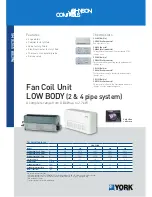
49-6000245 Rev. 3
15
AIR SUPPLY AND VENTILATION
Proper air supply and ventilation are essential to
the safe, effective operation of this residential gas
water heater. Air supply and ventilation must be in
accordance with local codes or, in the absence of local
codes, the National Fuel Gas Code, ANSI Z223.1/NFPA
54 or the Natural Gas and Propane Installation Code,
CSA B149.1.
Air Supply
This water heater is designed for use as a Category
I, natural draft, non-direct vented water heater which
takes its combustion air either from the installation area
or from air ducted to the unit from the outside.
If the water heater is installed in an open room of a
conventionally constructed building, sufficient air is
typically present for proper combustion and ventilation.
However, if the water heater is installed in a confined
space or tightly insulated home, additional provisions
must be made for combustion and ventilation air. A
confined space offers less than 50 cubic feet of air
per 1,000 BTUH (British thermal units per hour) for all
the appliances in that space. Each appliance’s BTUH
requirements should be listed on its rating plate.
Air supplied only from inside building:
Air must be
supplied through two permanent openings of equal size
located within 12” from floor and 12” from ceiling for
confined spaces. The free area of each opening must
be at least 1 in
2
for every 1000 Btuh of the total input
rating of all appliances located in the space, but not
less than 100 in
2
.
Air supplied only from Outdoors:
Air supplied
from two openings (as specified above), must have a
minimum free area opening as shown below for the
total input rating of all appliances installed in space:
Vertical Ducts or direct to outdoors: 1 in
2
for every 4000
Btuh.
Horizonal Ducts: 1 in
2
for every 2000 Btuh.
Air supplied from a Single Duct opening must provide a
free opening of 1 in
2
for very 3000 Btuh.
The minimum rectangular duct opening must be no
less than 3”.
If duct openings which supply combustion and
ventilation air are to be covered with a protective
screen, the net free area (opening in material) of the
covered material must be used in determining the size
of the opening. Protective screen for openings MUST
NOT be smaller than a ¼” mesh opening to prevent
clogging.
DO NOT block or obstruct any of the combustion
air inlet openings located around the perimeter of
the water heater.
Without an adequate supply of clean air, the water
heater’s pilot light will not function properly, and
excessive amounts of carbon monoxide may be
produced.
Installation Instructions
INST
ALLA
TION INSTRUCTIONS
THERMAL EXPANSION
If the home’s inlet water line includes a check valve, this will
prevent water from flowing back into the city’s water supply,
creating a closed water system in the home. Heated water
expands, causing increased pressure, which is then trapped
in a closed water system. Referred to as thermal expansion,
this rapid pressure increase can cause the water heater’s
relief valve to operate (releasing water) during heating
cycles, potentially causing premature failure of the valve
or the water heater. To control thermal expansion, install
a thermal expansion tank in the cold water line between
the water heater and check valve, as shown in the next
illustration, page 16. Contact your installing contractor, water
supplier or plumbing inspector for additional information.
AIR SUPPLY AND VENTILATION
(Cont.)
Corrosive Atmospheres
A corrosive atmosphere is created when compounds from
aerosol sprays, cleaning products such as bleach and
detergents or other chemicals become airborne and are
drawn into the combustion air supply of a water heater or
other gas appliance. When these compounds pass through
the gas flame, they create corrosive elements that shorten the
life of the appliance. Damage due to a corrosive atmosphere
is not covered under the warranty.
Ventilation
When an existing Category I appliance is removed or
replaced, the original venting system may no longer be
sized to properly vent the attached appliances. Vents must
be adequately sized per local codes or in absence of local
codes, the National Fuel Gas code to prevent formation of
condensate, leakage, and spillage of flue gases.
The ventilation system for this water heater must be properly
installed by a qualified service technician and free from any
obstructions. The vent should not be shared by any power-
vented appliance, nor should a damper be used anywhere in
the system.
The water heater shall not be connected to a chimney flue
serving a separate appliance designed to burn solid fuel.
The new vent hood (provided with the water heater) must
be attached to the gas vent or chimney by vent pipes. The
diameter of the vent pipes must match that of the vent hood
or be larger.
A UL listed Type B double-wall or single-wall metal vent pipe
must be used. Follow vent pipe manufacturer's instructions
for clearance to combustible materials. Clearance for
single-wall vent pipe should never be less than 6".
At least 12” of vertical vent pipe is recommended from the
vent hood. Horizontal pipes must maintain a vertical pitch of
at least 1/4” per foot, and the termination must be vertical.
Vent joints must be secured by an approved method, such as
sheet metal screws.
After the water heater’s main burner has been in operation
for 5 minutes, the vent hood can be tested for spillage
by holding a lighted match or candle close to the vent
hood relief opening. The smoke or flame should be pulled
towards the opening.
















































